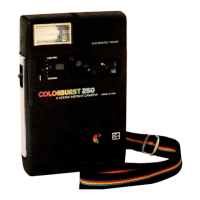LIGHTEN/DARKEN
CONTROL
Under most
conditions
, you
will
be taking
pictures with the
lighten/darken
control
in the
center
position. However, the light-
ness
or
darkness of your prints can be
affected by such factors as temperature,
and type and brightness of your subject.
The
lighten/darken
control
helps you to
compensate
for
these effects in
either
daylight
or
flash pictures.
After taking a
picture
,
if
you want a
lighter
or
darker
picture
of
the same sub-
ject
in the same location
without
chang-
ing the
lighting
or
your position, adjust
the control
before
you take another pic-
ture. To take a
lighter
picture
, move the
control toward LIGHTEN; for a
darker
pic-
ture, move the control toward DARKEN.
The
control
doesn't
automatically
re-
turn
to the
center
position
after you take
a
picture.
Temperature Effects on Prints
The recommended temperature range
dur-
ing development of prints is
60
to 100°F
(16 to 38°
C)
. At temperatures below 60°F
(16 °
C)
, place prints in a warm
place-an
inside
coat
pocket,
for
example-as
soon
as they are ejected from the camera, and
leave
them
there
during
development.
Otherwise, prints may
appear
too light. Be
sure not to bend
or
fold the prints.
It
may be advisable at the upper end
of the temperature
range-approaching
100°F (38 °
C)-to
set the control toward
LIGHTEN to keep prints from becoming
too dark.
Don't leave prints in
direct
sunlight
or
on a hot surface during development.
Prints
will
probably
be too
dark
when
developed at temperatures above 100° F
(38°
C)
.
See
your
film
instruction
sheet
for
com-
plete and up-to-date information.
8
Subjects
and Lighting Conditions
In certain types of situations, you may
judge
your
subjects
to be too
light
or
too
dark. For example,
if
you are photograph-
ing a very
light
subject
in very
dark
sur-
roundings,
your
main
subject
may be too
light
in your print. A
dark
subject
in
light
surroundings may appear too
dark
.
Under such
conditions
, the
lighten/
darken control can help you achieve more
pleasing exposure
of
your main subject.
See the examples on page
12.
Judging
Your Prints
Don't attempt to make
critical
judgment
of
print
appearance until development is suf-
ficiently
advanced. A 2- to 3-minute
wait
is
usually adequate
under
normal tempera-
ture conditions.
NOTE: Prints
will
appear
lighter
when
judged
in
direct
sunlight than they
will
under normal room lighting.

